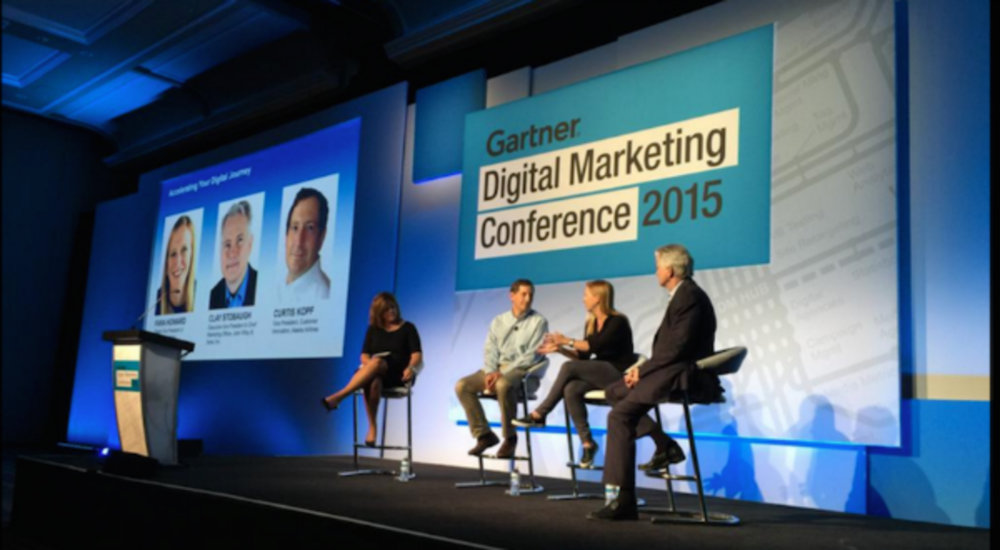Photo courtesy of Gartner for Marketers
Yvonne Genovese kicked off the inaugural Gartner Digital Marketing Conference reminding attendees that, in marketing, old and new are colliding: “The theory of ‘right’ [right customer/message/time/channel] is still here,” the Gartner group VP said, adding the caveat that the explosion of channels has many marketers challenged to get “right” right. “You have to find customers where they’re living,” she added. In many cases, she said, this means rethinking how marketing is organized, adding or changing roles, and learning new skills.
Genovese brought three senior marketers—Fara Howard, Global VP of marketing for Vans; Curtis Kopf, VP, customer innovation at Alaska Air; and Clay Stobaugh, EVP and CMO of John Wiley & Sons—to the stage to discuss these issues and more. Here, some of their insights:
On digital challenges
Kopf: One of the toughest things is filling the [digital] skills gap. Another is that collaboration across channels is really complicated. But it’s essential to have consistency across touchpoints.
Howard: For us, digital has changed everything. Our core demographic is millennials. What we know is that they’re constantly glued to technology. We use data to know what our customers are into and then create content around that instead of “throwing and hoping.” It’s made us more thoughtful and better listeners.
Stobaugh: Digital has humanized the customer for us. The customer speaks to us through the data [we gather]; it brings their voice to life and makes them part of the conversation.
Kopf: Customer expectations are rising. The bar has been set by the likes of Apple and Starbucks; in our case, not by another airport. Amazon set the bar online…. It was built to be customer-centric. It’s hard to compete with a company like that when you might be retrofitting customer centricity into your organization.We have to keep up. That requires thinking differently to meet customer expectations.
Stobaugh: You need three things: mind-set, skill set, tool set. You can have the mind-set, but if you don’t have tools or skills you’re not [going to deliver an outstanding customer experience]. We’re training our team to be modern marketers and be on the same page.
Howard: We’re doing more to marry what happens in online and in-store. How do we present products to you and make it easy to buy? How do we bring the e-commerce experience into store [in a way that] solves a consumer pain point and makes it easy to buy?
On new and changing roles
Stobaugh: It’s amazing how many new roles there are in marketing—strategists, technologists, trainers for sales enablement, etc. Having a customer experience expert is new. I get nervous when there are too many chiefs [because] the definitions of those roles often aren’t clear.
Howard: Complexity happens as we make up new roles. They bump into everyone else, which slows progress instead of creating it. Roles and responsibilities have to be super clear, as do KPIs.
Kopf: In some cases there’s a need to change people’s titles. Today, you can’t really have a head of digital because digital is a part of everyone’s job.
Stobaugh: Yes, digital is going away and it will just be marketing.
On using data for customer experience
Howard: Data gives us a better understanding of what our customers are into and allows us to have better conversations with them. Also, qualitative information provides perspective on what we put in the market and on what the consumer wants to hear about, and then we can jump into the conversation.
Kopf: For frequent flyers, we know everything from their drink preference to their loyalty level, but flight attendants don’t have that information at their fingertips. So, we know you but we treat you like we don’t. It’s a simple problem that we’re working to solve.
Howard: When brands don’t know their [key] customers, [it’s like]: I love you and you don’t even know my name.
On becoming a CMO
Stobaugh: As CMO, you have to be influencer and evangelist. And you need facts; facts are irrefutable.
Howard: You need to be curious and willing to take risks. That seems obvious, but today marketers often have to jump into the unknown.
Kopf: CMOs need to be data-driven. Everyone thinks they’re marketers. So, you have to use facts and data to make your case. Marketing will have a more influential seat at the table when they bring facts like other disciplines do. Also, you need to understand technology and agile marketing.








